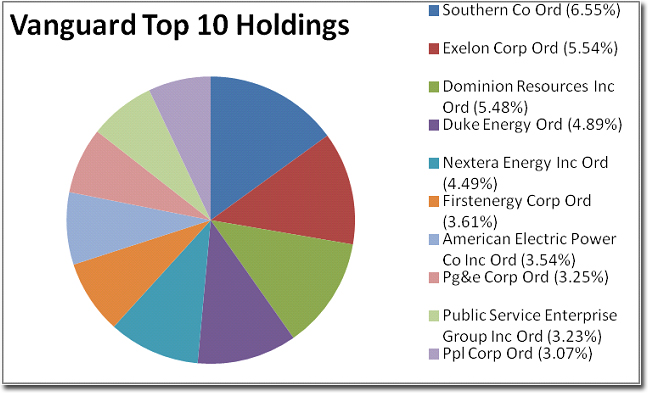 In this week’s fund analysis I’m going to dive into a pair of high quality Utilities funds. Known for their ability to produce consistent incomes from distributions, while holding consistent prices, Utilities are a must-have for any income-focused portfolio. However, since all of these utilities companies seemingly offer the exact same products, and all of these funds generally hold the same positions, how is it that we can differentiate between all of our options?
In this week’s fund analysis I’m going to dive into a pair of high quality Utilities funds. Known for their ability to produce consistent incomes from distributions, while holding consistent prices, Utilities are a must-have for any income-focused portfolio. However, since all of these utilities companies seemingly offer the exact same products, and all of these funds generally hold the same positions, how is it that we can differentiate between all of our options?
By the end of this week’s two part series, I’ll show you a couple of easy tricks for distinguishing which fund is most applicable to your portfolio by comparing Vanguard’s Utilities Index Fund (VUIAX), and FBR’s Gas Utility Fund (GASFX).
Objective & Strategy
Both of these funds pursue an objective to pursue investment income and capital gains that correlate to an index of natural gas and transmission companies. Keep that in mind, these companies are not aiming to out-perform, they are aiming to match the performance of the general market, and then distribute earnings from that index to investors.
Comparative Performance & Benchmarking

Remember how it is that these two funds are aiming to simply track an industry index? It doesn’t take more than a glance at the comparative returns of these products to realize that there is definitely more to this ‘index’ selection than meets the eye. If these funds were both truly a diversified index representing the industry returns as a whole, we shouldn’t be able to see such a dramatic different in returns for these funds. Think that’s interesting? The discrepancies only compound from here.
Distributions
The FBR fund produces respectable distributions of approximately 2% (not much).

Alternatively, the Vanguard Fund offers a yield of about 2.8%. Still a small distribution, but noticeably higher than its competitor. This does not come near to making up for the difference in returns between the two funds.

Capital Gains
The FBR fund has been producing respectable returns over the last three years, even considering a particularly depressing year in 2009.

Comparatively, Vanguard has near doubled the returns of the FBR fund over the last three years, even though it practically mirrored the returns of the FBR fund before 2009 (including that big crash in 2008). This seems to suggest that the Vanguard fund has selected a more robust basket of stocks, demonstrating a greater capacity to recover after that big market crash.

Capital Requirements & Fees
The FBR fund requires a minimum investment of $2,000 to purchase into the fund, and then proceeds to charge expenses at an MER of 0.76%, without any trailers or commissions (Loads). This compares to an industry average of approximately 1.12%, coupled with about 3% in front/back-end loads, making for a favorable expense ratio. Alternatively, the Vanguard fund suddenly reveals itself as being an extremely exclusive holding.
While the management expense ratio is only 0.19%, the fund requires $100,000 as the minimum investment balance. While this is an extremely low ratio, it is a much higher nominal value. While a minimum investment in the FBR fund costs only $15, a minimum investment in the Vanguard fund costs nearly $200. Granted, the scale is way off ($100,000 of investment in the FBR fund costs $760), it creates an interesting illustration of what kind of returns and costs are available to investors with access to large volumes of capital.
Take note that sometimes larger banks are willing to buy larger lots of high-initial-investment stocks, and then break them up for smaller investors into a product known as a ‘mutual fund wrap’.
Risk Metrics
When evaluating the risk profiles of the two funds, it becomes apparent that the FBR fund has a slightly higher statistical volatility than the Vanguard fund, with a Standard Deviation of 14.76, as opposed to Vangaurd’s 12.68%. These are both compared to an industry comparison of 13.75. However, what’s interesting to note is that the difference between these two standard deviations is fairly nominal. Of more value to us for evaluation is the alpha metric of both these funds.
Alpha measures the returns of the fund that exceed what would be expected, given the fund’s exposure to the overall markets (beta). While the Vanguard fund maintains an alpha near .5 against a beta of .44, the FBR fund is currently maintaining a .75 alpha against a .68 beta. Again, while the numbers are representative of differences in volatility, the greater difference between alpha and beta in the FBR fund seem to represent a greater ability of management to obtain benefits of scale.
Holdings
When evaluating the different holdings of the FBR and Vanguard funds, it becomes difficult to differentiate between the two funds. While the Vanguard fund holds 86 companies (as opposed to an industry average of 95), the FBR fund narrows its holdings to only 65 specific companies, despite being the larger of the two funds.
Additionally, the FBR fund has allocated approximately 25% of its fund towards Oil & Gas producing investments, while the Vanguard fund remains 99% dedicated to Utilities. Lastly, the Vanguard differentiates itself by having a slightly greater exposure to its largest holdings, even though it holds so many different companies already.


Conclusion
Both of these funds provide an interesting contrast to each other. While they both represent a desire to index the Utilities and Natural Gas industries, there are some obvious differences between them that create some very remarkable distinctions between the application and returns of the fund practices deployed. In the next posting, I’ll take you through a couple of perspectives that can be used to evaluate these funds for your specific portfolios, and how we could look at both of these funds as potential investment opportunities.



